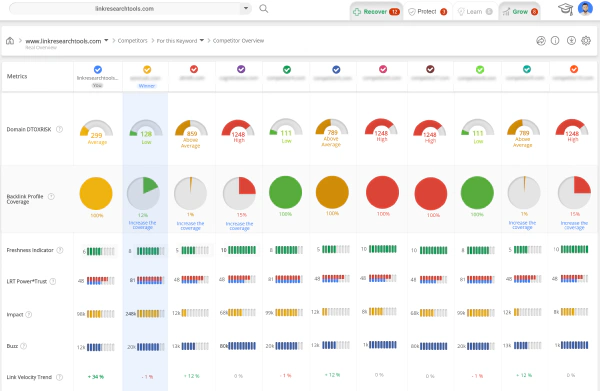SEO Competitor Analysis Tools
All Competitor Analysis Tools of LRT
Get an edge™ for your SEO with LRT.
Competitive Landscape Analyzer
Analyze Competitive SEO Landscape.
Do a little better than your competition and WIN! Compare your competitors with your website and learn how to outrank them.
Competitive Link Detox
Find great healthy links your competition has.
Outrank your competition quickly. With Competitive Link Detox (CDTOX) you can understand link ratios and risk levels for your niche and find strong links that your competitors have.
Quick Domain Compare
Compare SEO metrics for domains.
Compare domains in seconds. Compare your site with your competition and find out in seconds who is doing best and why.
Strongest Sub Pages Tool
SSPT Link Building Method.
Find the strongest pages of any website. See the strongest subpages and sub-folders of a domain and find the best place for your link.
Link Alerts
Link Alerts - Like Google Alerts for Links.
Get an e-mail notification whenever you get new links. You can use this monitoring technique to follow your competitors as well.

What is Competitor Analysis in SEO?
Competitor Analysis in SEO refers to analyzing and monitoring your competitors in various aspects, including their search engine optimization (SEO) to learn from their methods and mistakes. Understanding the backlink profiles of your competition and comparing them to your own is vital for various reasons. It is, of course, the most important step in link building if you want to find out why they are ranking better than you and how you can do better than them. It is also essential to inspect the common link risk in your niche so that you can continue to boost your rankings without moving into the penalty area. Therefore, the Competitive Analysis should be a solid foundation of your SEO strategy.

Competitive Analysis Workflow
You can get the most powerful results out of the Competitive Analysis when you know exactly when and how to use it.
Find Competitors
It might be possible that you don’t even know who your competitors ARE if you are new to the market or just started working with a new client. In that case, you need to ask yourself: what keywords should the site rank for? When you figured out the keywords, you can check who ranks for them and these are your competitors.
Recommended tool: CKA
Understand the risk level in your industry
By analyzing the link risk levels in your industry using a tool like CDTOX you can gauge how many bad links their competitors have, and what they probably disavowed. You should then compare the risk for your domain with the overall DTOXRISK in your niche. This way, you can get an idea will how many and which links you are supposed to remove or disavow without shrinking your backlink profile too much.
Reverse Engineering their Link Building
If you already went past that struggle, then it is time to start outperforming your competitors. To do this, you need to understand WHY your competitors are ranking better than you and WHAT you need to do to blend in and do just a little better. You need to consider many metrics as well as different ratios like keywords and Follow / NoFollow links to understand how your niche works.
Recommended tools: QDC, CLA, CDTOX
Understanding Link Velocity
When you have decided on a link building strategy to outperform your competitors, it is still imperative to understand the concept of Link Velocity. If you build all your good links at once, you will get a sudden boost in your rankings, followed by an algorithmic penalty (or worse). This is why you need to understand the natural link growth in your niche and then start building at the right pace.
Recommended tool: CLV
Conclusion
Competitive Analysis Tools are very powerful for finding the right competitive SEO strategy. Use them before taking action and always be one step ahead of your competition in the rankings. If you understand how your competition got their rankings, you will know exactly what links to look for and can proceed by prospecting for link opportunities.
Competitive Landscape Analysis is a synonym for competitor research and gave a component in LRT its name.
Benefits
Learn more about
The Interflora Penalty caused quite some attention in the industry. This case study demonstrates use of Link Detox Classic to audit the problems.
Home24 was one of the first victims of the aggressive Google Penguin 2.0 penaly. This case study demonstrates use of Link Detox Classic to find obvious and not so obvious spam problem. Most notable is the new impact that spammy redircts had.
See how Christoph C Cemper used the Link Check Tool (LCT) to check the status of 4,649 spam link examples for 854 domains collected between August 16, 2013, and July 2, 2014. The results will surprise you.
The NoFollow 2.0 attributes introducd changed the game for SEOs... read why.